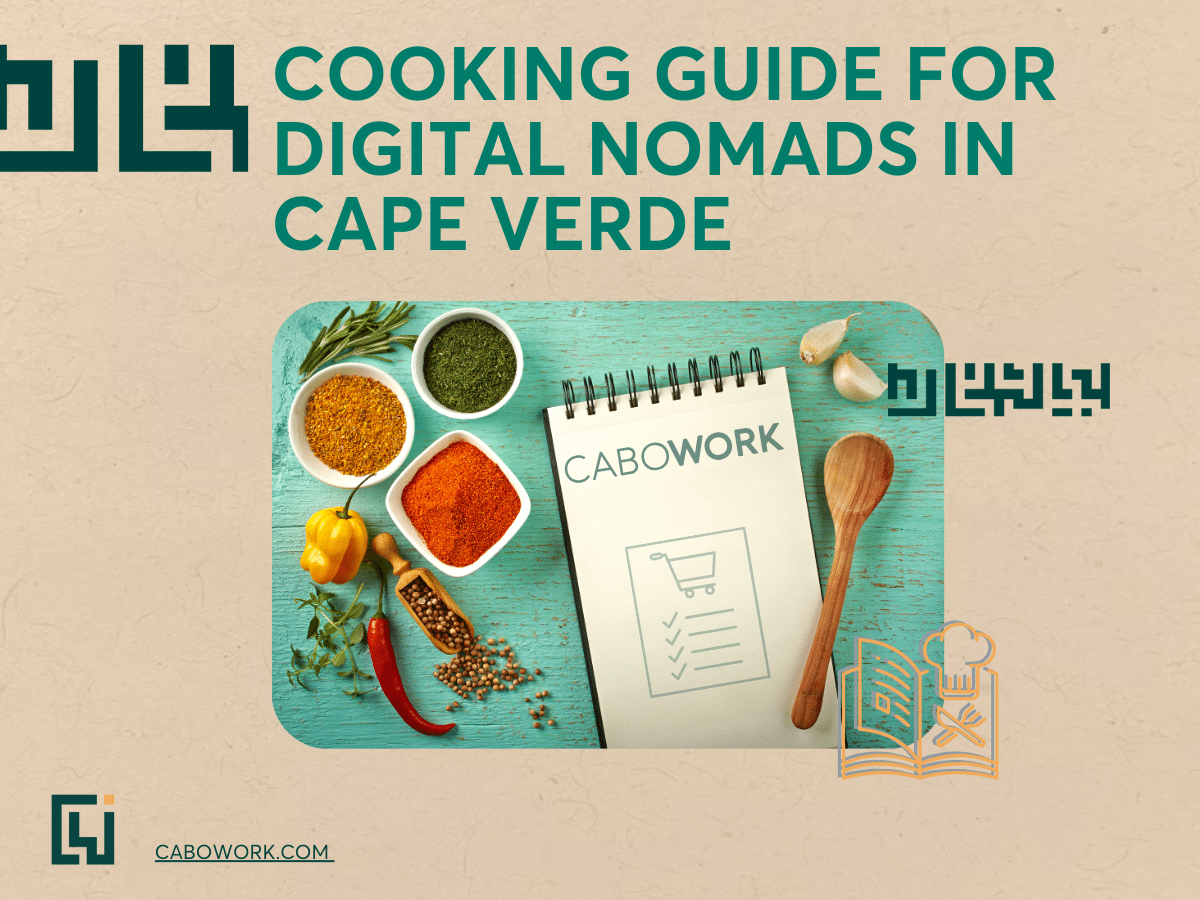Cape Verdean Cuisine is a Fusion of Flavours
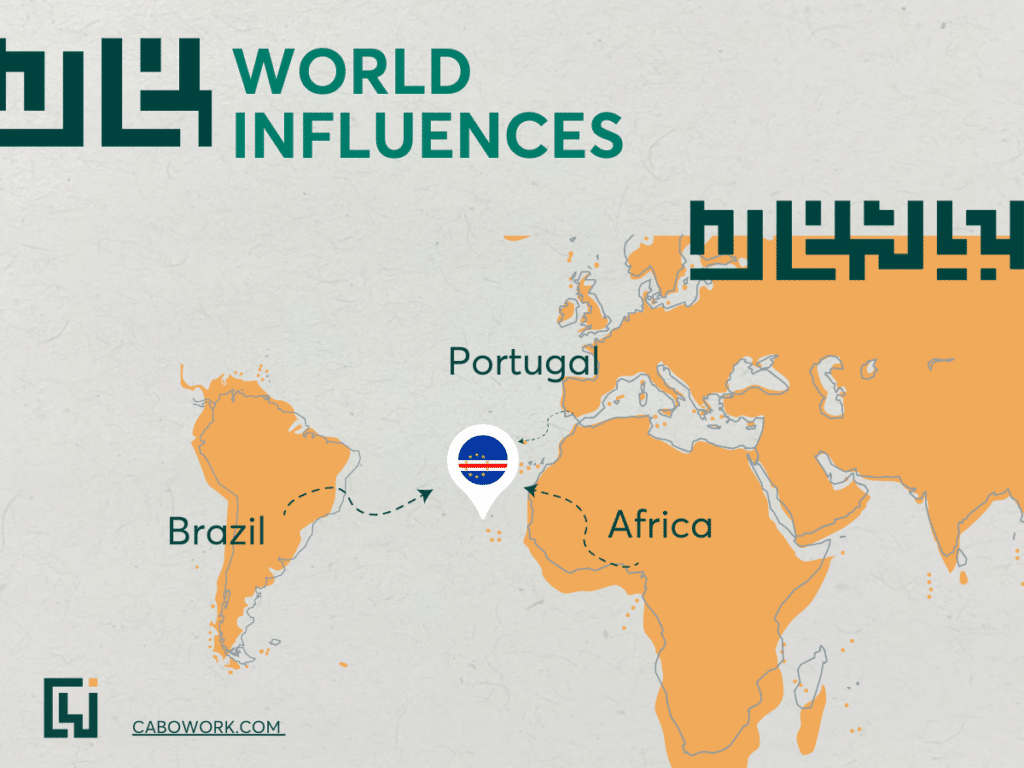
Cape Verdean cuisine is the result of centuries of African, Creole and Portuguese influences.
One of the secrets of Cape Verde culture and the basis of its cuisine lies in the fresh and locally sourced ingredients. This unique combination results in a wide range of dishes, each brimming with several flavors, aromas, and textures.
The islands are rich in fruits and vegetables. Papaya, banana, coconut, sweet potato, beans and broad beans are often used to make traditional dishes.
The surrounding Atlantic Ocean provides fresh fish and seafood to this culinary landscape. Spices such as bay leaves, chili peppers and also cumin, enhance the local flavors.
The result is, of course, an unforgettable culinary journey.
Cape Verdean Food: Top 10 Dishes
If you’re planning a visit to any of the Cape Verde islands (maybe all of them?), get ready to delight your taste buds! Cape Verde’s unique island cuisine is a blend of African and Portuguese influences that will offer a culinary feast for any visitor.
From the national dish known as “Cachupa” to the creamy “Pudim”, this cooking will please all palates, especially those with a sweet tooth. Below you’ll find a list so you can get familiar with the most famous Cape Verdean dishes.
Cachupa, The National Dish

Cape Verde’s national treasure is a hearty stew made with corn, beans, and fish (cachupa pobre) or meat (cachupa rica). Cachupa is a versatile dish and can have several variations, depending on the region and the ingredients available, making it a testament to Cape Verdean culinary cleverness. It is quite normal for the locals to dine Cachupa and if there are any leftovers, they’ll have it for breakfast the next morning.
Caldo de Peixe
Caldo de Peixe is a fish broth that warms the soul with its comforting blend of fresh fish, tomatoes, onions, peppers, and a touch of spice. It’s also not surprising that it comes with bay leaves, or coriander. Often served with rice, it’s a delicious option for lunch or dinner.
Pastel

These fried pasties are usually filled with a delicious mixture of tuna, onion, tomato, and spices. They are served as a snack or appetizer in restaurants and cafés all over the country. Be sure to eat one (or two!) to experience the explosion of flavours of this Cape Verdean food.
Bol de cus cus
This is a couscous-shaped cake. It’s a dish made from corn flour, a very popular ingredient in Cape Verde. The “bol de cus cus” is served with fresh goat cheese, butter and sugarcane syrup, and is steamed.
Feijoada
This is a bean stew with rich flavours, similar to the Brazilian version, but cooked with pork, beef, chorizo, and Cape Verdean spices. Traditionally, it is accompanied by rice.
Xerém
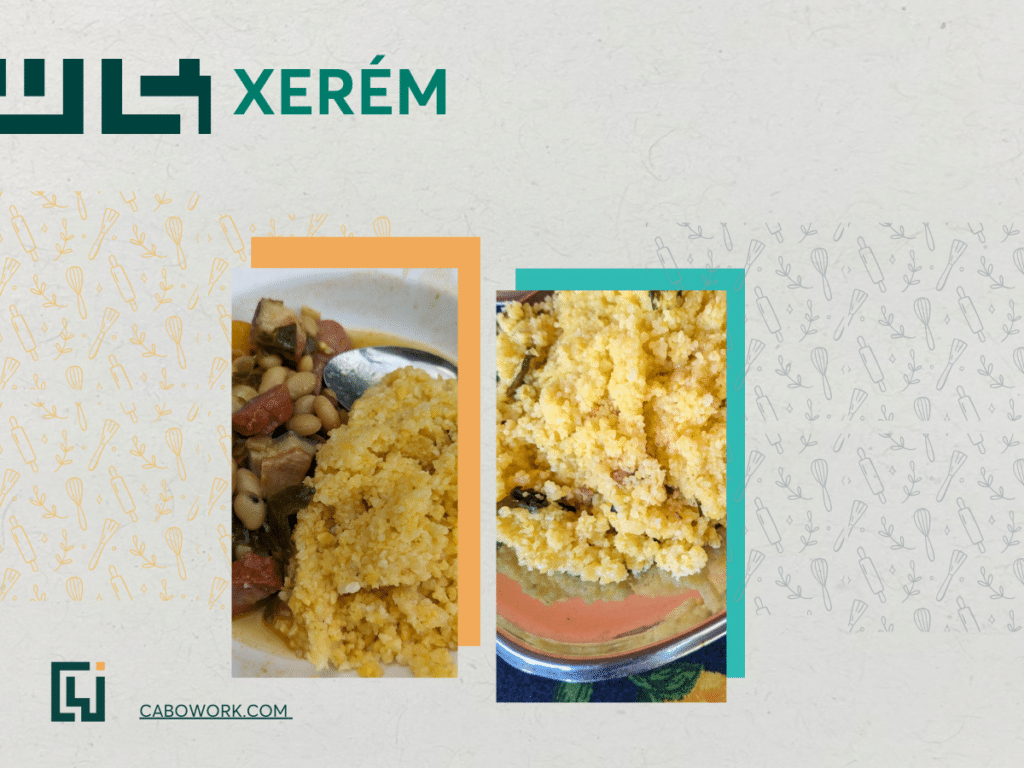
For a taste of the Portuguese influence, try xerém. This dish consists of porridge made with corn flour and has Moorish origins. The side dishes vary according to the region, to offer a unique gastronomic experience in different parts of the islands.
Pudim
Of course, no culinary adventure is complete without a good dessert, for a sweet tooth. Cape Verde pudding, is the Cape Verdean version of the “spanish flan” — a creamy flan pudding made with milk, eggs, sugar and spices, is a delicious way to end any meal. Don’t miss the chance to try the local version of this classic dessert.
Fried Moray Eel
Fried moray eel is a very popular seafood dish. The eel is marinated in a mixture of garlic, lemon juice and spices and covered in a light batter before being fried to a crisp.
Canja de Galinha
Canja de Galinha, or Chicken Soup, is one of Cape Verdeans’ favourite dishes. Served on special occasions or as comfort food, when someone’s feeling ill, it is a delicious option for those looking for the taste of home cooking.
Goat Cheese and Papaya Jam

This is one of the most famous dishes in Cape Verde. This unique and unexpected combination of goat’s cheese and papaya jam offers an excellent contrast of sweet and salty flavors.
How to Cook Cachupa – Recipe
Ingredients
Meats
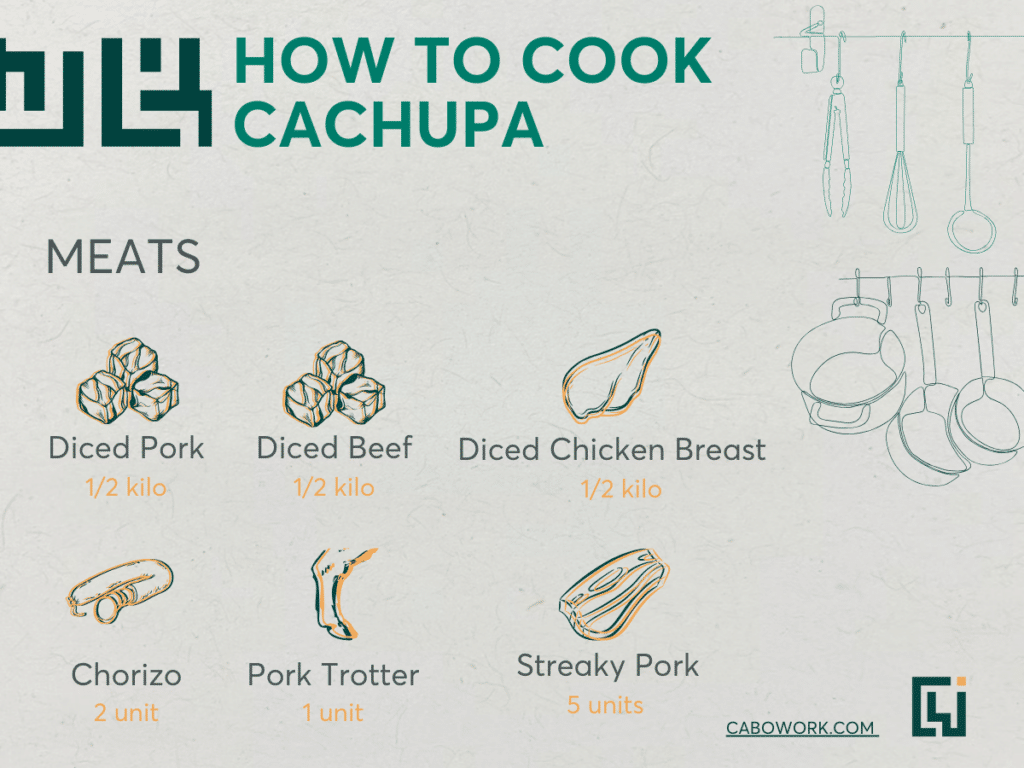
Vegetables and spices:
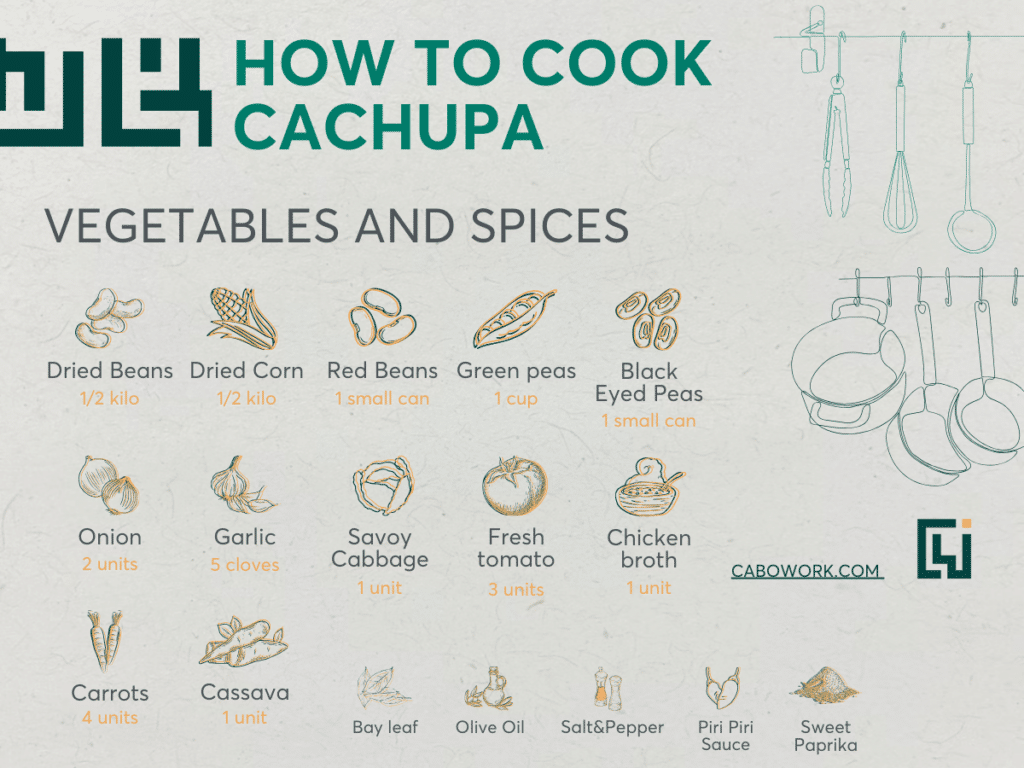
Choose one of the following ways:
- Soak dry the beans and corn for 12 hours. Drain the water and cook in one pan with water and seasonings.
- In a pressure cooker, cook the beans and the corn with water and seasonings for around 45 minutes.
- In a pan with water and seasonings, cook the beans and the corn for 2 hours (without soaking).
Cooking Cachupa: consider this third option for the most traditional dish
Add olive oil, bay leaves, garlic and onion to a pan and fry. Add sweet paprika and mix well. Then, add hot water and cook the dried beans and corn, without adding salt.
During cooking, add more hot water when required. Repeat the process until the dry beans and corn are well cooked. Once cooked, set aside. Important: Do not drain the corn and beans cooking water.
Add seasonings all over the meat with salt, white pepper, sweet paprika and spicy sauce. If possible, leave it to marinate for a few hours. After seasoning the meat, add olive oil to a large pan. Once hot, fry the onions, bay leaves, the chicken broth and garlic.
Add fresh tomatoes and marinated meats. Fry them until they gain a nice colour. Rectify the seasonings if necessary, and cook with the pan covered for about 45–60 minutes, or until well cooked. Once cooked, add the chorizo in slices, the black-eyed peas, and the red beans. Let it cook in the pan on medium heat until tender. Rectify the seasonings as needed.
At this stage, choose one of the following ways to continue:
- Add the vegetables to the big pan where the meat is.
- Cook the vegetables in a different pan.
If you prefer not to mixture the different flavours, choose the second option:
- Cook the sliced carrots, sliced cassava, green peas, and savoy cabbage in a pan with hot water and a bit of salt for about 15 minutes. When done, add them to the big pan (along with the cooking water), followed by the dried beans and corn. Mix everything together and let it cook until the sauce thickens a bit. For the final part, sauté in olive oil, onions, and garlic. Pour it into the pan and serve.
Cooking as a Digital Nomad: Tips for the Adventurous Foodie
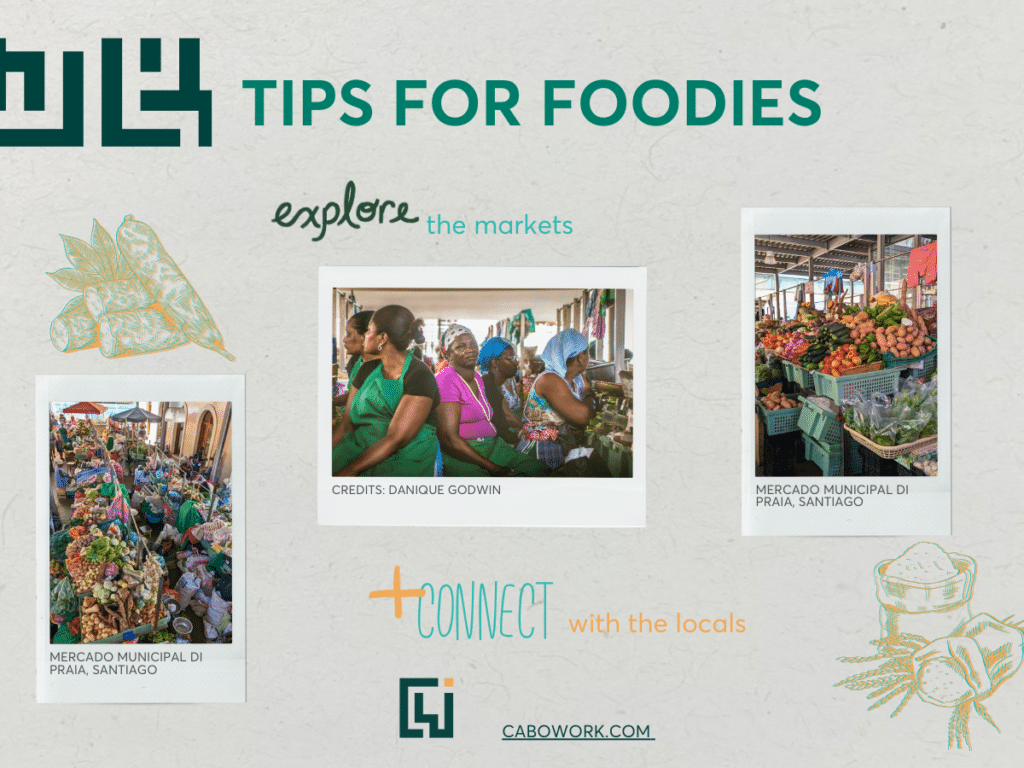
Embrace the Local Markets
Immerse yourself in the vibrant atmosphere of local markets like the Mercado Municipal da Praia in Santiago or the Mercado de Sucupira in São Vicente.
Here, you’ll find a colorful display of fresh produce, meat, fish, exotic fruits, vegetables, and spices at reasonable prices, perfect for creating your own culinary masterpieces.
Learning some basic Portuguese or Cape Verdean Creole can not only help you avoid price inflation and maintain a reasonable cost of living in Cape Verde but will also allow you to connect with the vendors and gain valuable insights into local cooking traditions.
Connect with the Community:
Learning from locals is one of the best ways to experience authentic Cape Verdean cuisine. Cooking classes, workshops, or gastronomic events are also great ideas for learning more traditional techniques and recipes. Alternatively, volunteering at soup kitchens can be a way to give back to your community while learning and interacting with people who share the same interests as you.
If you’re a digital nomad looking for a place to work remotely, know that in Cape Verde you’re sure to find your perfect work haven. Discover locations full of potential to become your favourite place to work. Take a look at this article to find out more about some of them.
What is the “Prato do Dia?”
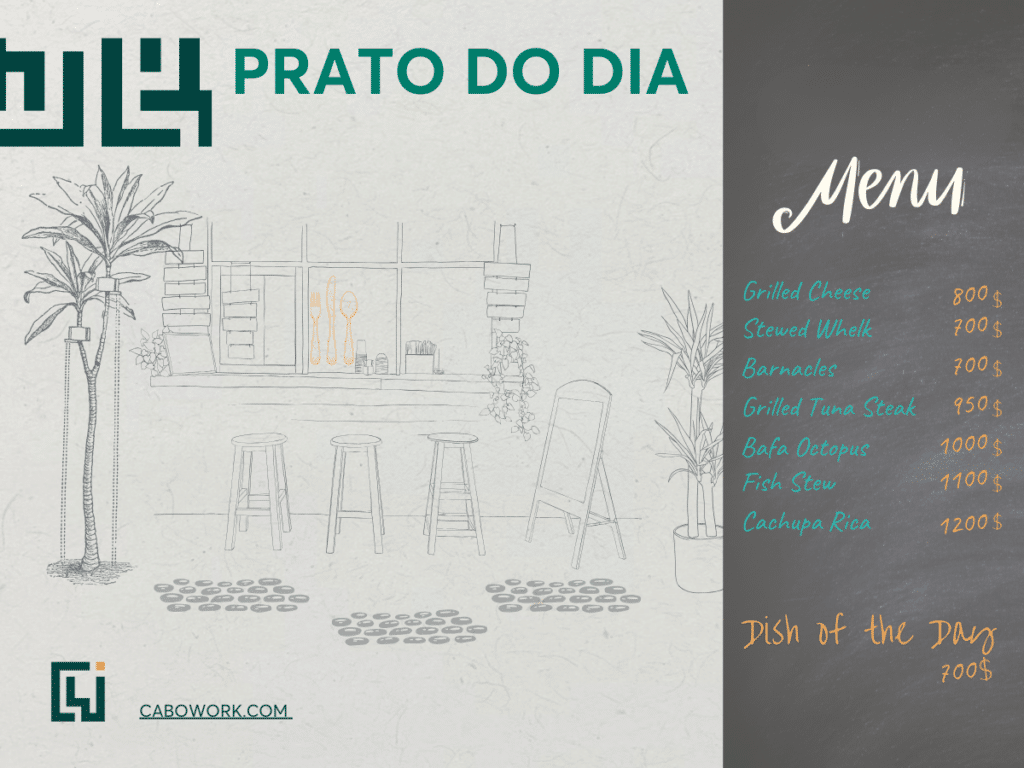
Truth be told, cooking requires time, effort, and some skill, even if minimal. If you’re eager to try the country’s delicacies and don’t have time to waste, Cape Verde offers a wide variety of gastronomic options, from busy restaurants to charming cafes.
Try the “Prato do Dia”, the daily dish offered by the vast majority of establishments — it’s a complete meal, which usually includes a main dish, a side dish such as rice, beans or fries, and sometimes even a drink and dessert, all for a fixed price. This makes it an economical option to try different Cape Verdean dishes.
The “dish of the day” is usually served at lunchtime, although some establishments may also have a dish like this at dinner time.
Still curious about the “dish of the day”? Check out our article on how to find the best Dish of the Day in Santa Maria.
Discover each of the Island’s Flavours
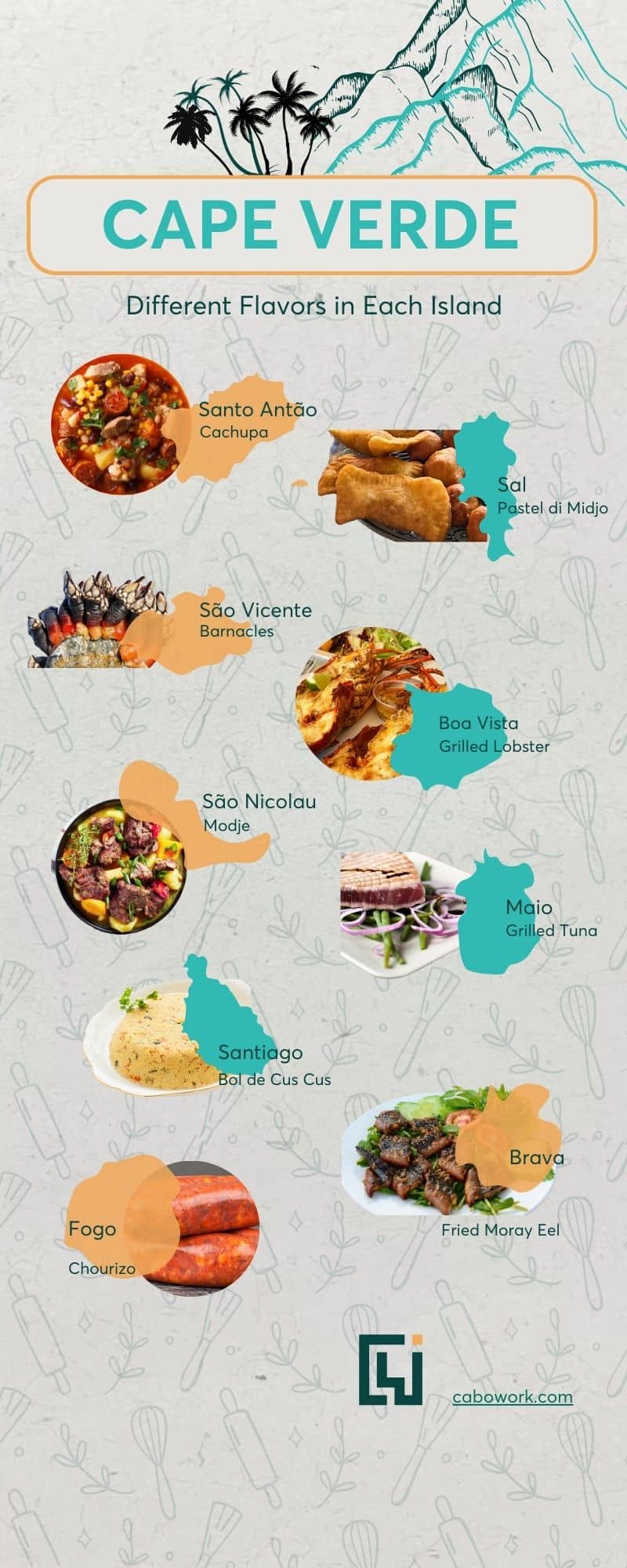
Each island in Cape Verde has a unique culinary identity, influenced by its specific history, geography, and cultural heritage. When travelling around the archipelago, make sure you experience the most traditional things the islands have to offer:
Santiago Island — try the corn couscous. Made with corn flour, it is steamed inside a “binde”, a special clay container. This traditional preparation method is linked to African roots and is a centuries-old legacy.
São Vicente Island — immerse yourself in the flavours of a cuisine known for its fresh seafood dishes, such as barnacle stew or fried moray eel.
Sal Island — indulge in the Sal Island specialities, like cornflour pastry, locally called pastry “de midjo”, which is a fried dough filled with tasty mixtures, such as fresh tuna or meat.
Boa Vista Island — on this island there is a range of dishes made with seafood, such as grilled lobster and octopus, to several varieties of fish cooked in coconut milk or a fish broth infused with the island’s distinct flavours.
Fogo Island — embark on an authentic culinary adventure on the volcanic island of Fogo. Explore the unique flavours of “gufongo”, a cornmeal puff pastry, and savour the rich, smoky flavour of chorizo — a local blood sausage. Don’t forget to try djagacida, a dish made from corn flour, mixed with beans, cabbage, and various types of meat. Also try the Chicken with “azedinha”, a great and delicious combination of sweet and sour.
São Nicolau — here, the traditional option is Modje, a hearty goat stew, that it can also be made with lamb, beef, or chicken. This stew is prepared with yuca, sweet potato, green banana, and yam.
Island of Maio — on the island of Maio, tuna steak is the king of traditional dishes, alongside fish and seafood. Don’t forget to taste a good grouper or another of the delicious fish that are sold in local restaurants and markets.
Brava Island — traditional gastronomic specialities on Brava Island include dishes such as Totoco, a dish made with corn fritters in a meat or fish stew; xerém, mountain fish and moray eel, seafood like limpets and shells or meats such as goat, pork or chicken.
Santo Antão Island — the most traditional dish in Santo Antão is the Cachupa, but don’t miss the opportunity to try papaya jam, a local delicacy made with papaya, as well as guava and mango sweets. In addition to these sweets, Santo Antão is famous for the production of Grogue, which is one of the most traditional drinks. Drunk throughout the archipelago, Grogue is the result of the distilled sugar cane.
Besides Grogue, Pontche is also one of the traditional drinks amongst the islanders. A liqueur that is made by combining Grogue with honey or molasses, and sometimes lime juice. Unlike Grogue, which is a powerful and pure sugar cane spirit, Pontche is mild and sweet.
Traveling to Cape Verde and need more safety tips? Read our complete guide.
